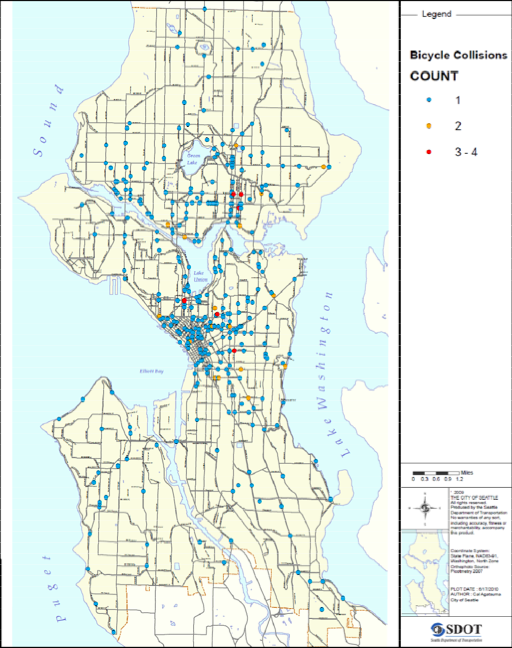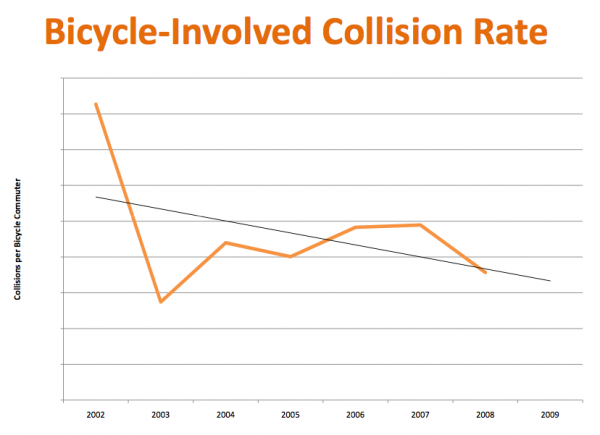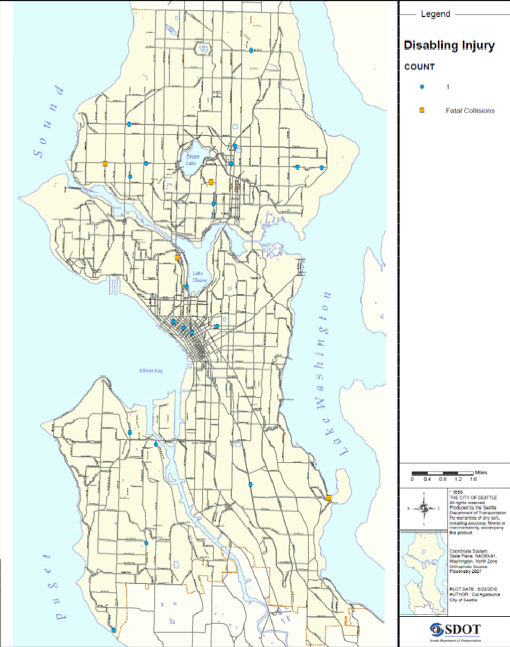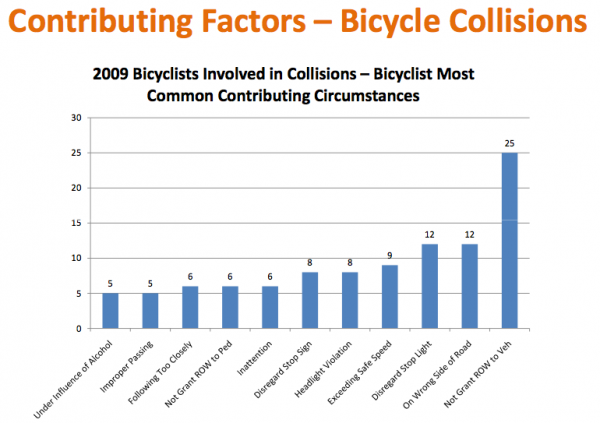
Despite the fact that Seattle’s population is growing, traffic volumes and collisions both went down in 2009. The data was collected by SDOT for their 2009 Traffic Report, which was released last week. Flip through the presentation after the jump.
2009 Traffic Report Presentation
The data shows that the collision rate actually dropped faster than the decrease in traffic volume. Bicycle collisions went up, but the collision rate went down due to the increase in riding.

Still, 2009 was a rough year for riding. There were 382 reported collisions involving cyclists (compared to 355 in 2008). 325 people on bicycles were injured, and four people on bicycles died. Here’s a map of where those injuries and fatalities occurred:

By far, the most common driver error contributing to a collision with someone on a bicycle was failing to grant the right of way to the person on the bike. Many of these are the “I didn’t see him/her” sort of collisions and other distracted driving causes. These are the sorts of collisions the Vulnerable Users Bill is attempting to address. Should negligent driving be an excuse for killing or injuring someone? Should drivers be able to simply mail in a check with their ticket and keep driving after killing someone? We need laws that take these kinds of collisions at least a fraction as seriously as the people whose lives are ended or altered by them.
For collisions where bicyclists were at fault, failure to yield right of way was the biggest cause, followed by riding on the wrong side of the street and running stop lights.
 So ride safe, everyone. Bicycle riding really is getting safer, but we have a ways to go. We have made great gains in ridership (2010 ridership data should be out soon, says SDOT) and infrastructure since 2009. The collision rate is going down. We are also making good headway on new state laws that will make riding safer.
So ride safe, everyone. Bicycle riding really is getting safer, but we have a ways to go. We have made great gains in ridership (2010 ridership data should be out soon, says SDOT) and infrastructure since 2009. The collision rate is going down. We are also making good headway on new state laws that will make riding safer.
Below is the full SDOT 2009 Traffic Report. There’s a lot of data here, so pick through it and point out anything interesting you find in the comments.









Comments
4 responses to “SDOT’s 2009 traffic report shows drop in bicycle collision rate”
Any idea what “Not grant right-of-way to vehicle” means in the context of contributing factors to bicycle collisions? I’m trying to think of an example and can’t. At least, I can’t think of one that isn’t already more captured more specifically by one of the other factors (e.g., “disregard stop sign”).
Maybe this is the right-hook, where the car had the right-of-way to turn?
Looking at the glossary for definitions of the various injury categories left me with the impression that cycling in Seattle is already a very safe activity. There were very few collisions, of which, very, very few seemed to have resulted in significant injury. If you attribute some of those injuries to some of the knuckleheaded behaviors (e.g., no lights at night, inebriation, bike salmon) that none of us (cough, cough) engage in, it seems that your chance of injury while commuting in Seattle is very low.
When I get more time I’ll read through the SDOT report. However, I get the feeling that bike/car collisions are under reported. I check out bikewise alot and am generally surprised that the rate isn’t higher on the Burke as it goes from 15th NE to Brooklyn. Especially since many westbound drivers on Pacific don’t see you as you approach Roosevelt to cross the crosswalk and blow through to make the right north onto Brooklyn. I frequently see a lot of near misses.
However, in the 3 years and 15k miles I’ve spent year round bike commuting in the area I’ve only been hit one time, and that was in Bellevue. Generally speaking the downtown core is relatively safe to bike through now with a few exceptions.
As far as the failure to yield to a vehicle, my guess is that it’s at controlled and uncontrolled intersections where a bike is treated no different than any other vehicle. The car shows up first and has the right of way and the bike doesn’t yield, or the cyclist doesn’t stop at a red light/stop sign.
they probably are underreported, but I suspect only for the relatively inconsequential collisions — I’d be surprised to find that they’re missing many ER visits in the data since the police would likely be involved. That said, I’m not sure of the source of SDOT’s data on collisions — police reports?
alternatively, this could be just one of those situations of reality not matching what we expect to be the case. Seeing “a lot” of near misses doesn’t necessarily mean that a lot of collisions are happening. Maybe that intersection is only “almost dangerous” but not “actually dangerous?”
[…] and cities around the globe have experienced, as the number of people cycling in Seattle grows, the injury rate drops. Seattle is achieving this growth by making streets safer, building more bicycle facilities and […]